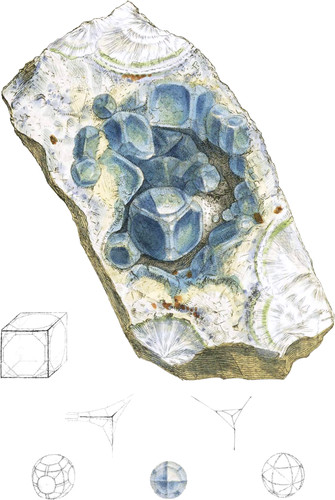 Enlarge
Enlarge
British Mineralogy
Fluor
Bere-alston Lead mine, in Devonshire, has of late produced many beautiful and curious varieties of Fluor; from a collection of these (kindly lent me by W. Lowndes, Esq, consisting of a series of crystals whose general form is the cube, with six faces, more or less deeply cut upon its solid angles, and some of which are almost spherical) the present has been selected as most novel in its appearance, and containing the greatest variety. The floor of this mine, particularly the more globular varieties, is characterized by a rough surface, as if it had been corroded, but the exemption of several of the facets of crystals, in other parts very rough, seems to infer that some circumstance at the time of their formation caused this appearance, or that the corroding substance must have been partially sprinkled over them. The matrix is hornstone, and it is accompanied by Quartz, Iron pyrites, and Argentiferous Galæna, in brilliant octohedrons, with their edges modified; the specimens are frequently very crumbly, liable to fall to pieces, and often without the honistone matrix, having been taken from large hollows. The crystals have not only the faces ranged around the solid angles of the cube, above mentioned, but often two and sometimes three faces upon the edges—there are also in smoother varieties or those approaching nearest to specimens from the northern counties, cubes around whose solid angles may be discerned twelve minute facets. A few of the globular crystals are produced by the extension of only three faces around each angle of the cube, or which leads to the same form, four faces upon each angle of the octohedron; as the six faces upon the angle of the cube are the same as eight upon the octahedron or primitive form. The face s of the cube on most varieties of Fluor are rendered slightly convex by the superposition of very low four-sided pyramids, the edges of the laminæ composing which are seen in strife, but upon the faces of these varieties there are often many little circular convexities, as if the crystals had been formed of drops and seldom any striæ except upon those laces situated around the angles of the cube, upon which they are sometimes rather strong. The globular appearance of the crystals is given them by the number of faces of which they are formed, amounting in the simplest to 24, and in the most complex to 80: in many it is rendered more perfect by the curvature of the six laces upon every angle of the cube amounting to 48, and producing crystals precisely similar to spheroidal Diamonds. The greatest number of faces obtainable from an assemblage of all the modifications exhibited in the plate would be 162.
The specimen figured contains a good series of crystals, with two faces at each edge and six at each angle: in the larger ones the faces of the cube predominate; in the smaller ones they are almost lost, and the crystals train a spherical contour. Between these crystals and the Hornstone are radiated, almost globular masses of Fluor, similar to that usually turned in Derbyshire into various ornaments, but smaller, and in such a state of decomposition as to become almost fibrous, and delicately white: the inside of the crystals is yellowish green; the surface pale violet: the usual colour of rounded ones from the same mine and seldom above half an inch over, is deep purple: the cubes are often dull yellow or whitish, and sometimes an inch, and half or more square. I have a small specimen with nearly white cubes, about the angles of which are placed three facets inclined upon the faces of the cube, leading to the most simple of the spherical forms, a corner of one of these is drawn.

